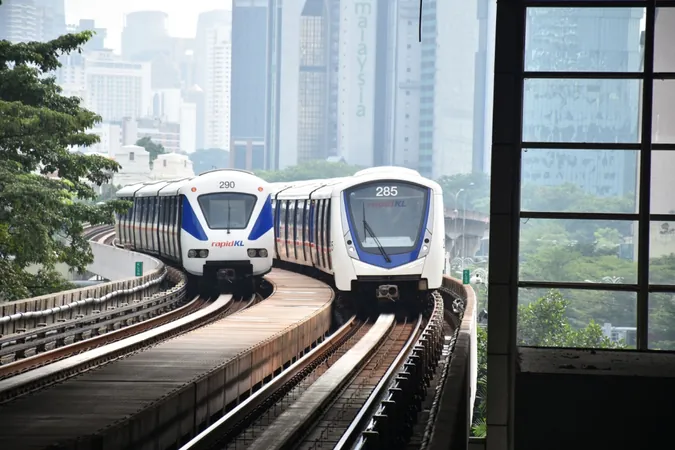
Is Profit the Goal for Public Transport? Lessons from 5 Countries
2025-07-06
Author: Nur
Malaysia's Struggle with Public Transport Funding
In a bold move, Malaysian Prime Minister Datuk Seri Anwar Ibrahim has declared that public transport will become the cornerstone of future urban planning, aiming to reduce the nation's longstanding dependency on private vehicles. However, this vision raises a critical question: Who will fund these ambitious transit projects?
Historically, Malaysia's public transport system has relied heavily on government subsidies. Yet, there is an ongoing debate about privatization, with advocates suggesting that profit-driven models could encourage innovative solutions and financial independence for transport operators.
Public Transport as a Social Service
Within Malaysia, opinions are divided. Many policymakers believe that public transport should be seen as a social service financially supported by taxpayers. Rajiv Risyakaran, a state assemblyman passionate about public transit, expresses that profitability shouldn’t be the main focus; rather, the emphasis should be on efficiency and expanding services. "I don’t expect public transport to be profitable; it’s a service the government provides for its citizens," he asserts.
Insights from Around the Globe
To explore how various countries manage public transport financing, here’s a look at five nations renowned for their effective transit systems, revealing the complexities behind profitability.
Japan: A Case of Unique Profitability
Japan boasts one of the world’s most efficient public transport systems, particularly its rail networks. Initially managed by governmental bodies, privatization in the late 1980s resulted from heavy debts incurred by the Japanese Railways (JR) due to policy shifts favoring car ownership. Today, JR’s regional companies have adapted services to their specific areas, and while passenger ticket sales contribute to revenues, diversification into real estate and retail near stations is pivotal for profitability.
Singapore: A Government-Controlled Success
Singapore has created a transportation model that is both admired globally and profitable. Here, the government owns critical infrastructure (like tracks and stations) while operators like SBS Transit manage the services. This structure alleviates significant capital expenses, allowing operators to achieve financial success.
Switzerland: A Balancing Act
Switzerland's transport network includes railways, taxis, and buses, covering vast distances, including scenic Alpine routes. Although the Swiss Federal Railways (SBB) has reported profits recently following pandemic downturns, like its counterparts in Japan, much of this revenue is generated through real estate diversification. However, substantial government subsidies are still crucial, covering up to half of the operating costs.
Germany: A Mixed Ownership Model
Germany's public transport system features a blend of private and public enterprises, with Deutsche Bahn (DB) as the major player. Despite its state ownership, DB must compete with private entities, and the system predominantly relies on federal subsidies. In 2021 alone, over 11.6 billion euros were allocated to support public transport, with additional funding anticipated.
Netherlands: A Social Responsibility Perspective
The Netherlands offers one of the most sophisticated and integrated public transport systems globally, known for its efficiency and coverage. Similar to Germany and Switzerland, Dutch operators depend heavily on government support. However, public sentiment strongly favors funding for public transit, viewing it primarily as a vital social service rather than a profit-making enterprise.
Conclusion: Rethinking Public Transportation Globally
As seen in these five nations, the relationship between public transport and profitability is far from straightforward. While some countries show paths to financial self-sufficiency, most still highlight the importance of government funding. The ongoing discourse in Malaysia parallels this global perspective, suggesting that public transport is not merely a business; it is an essential social service that critically shapes urban life.


 Brasil (PT)
Brasil (PT)
 Canada (EN)
Canada (EN)
 Chile (ES)
Chile (ES)
 Česko (CS)
Česko (CS)
 대한민국 (KO)
대한민국 (KO)
 España (ES)
España (ES)
 France (FR)
France (FR)
 Hong Kong (EN)
Hong Kong (EN)
 Italia (IT)
Italia (IT)
 日本 (JA)
日本 (JA)
 Magyarország (HU)
Magyarország (HU)
 Norge (NO)
Norge (NO)
 Polska (PL)
Polska (PL)
 Schweiz (DE)
Schweiz (DE)
 Singapore (EN)
Singapore (EN)
 Sverige (SV)
Sverige (SV)
 Suomi (FI)
Suomi (FI)
 Türkiye (TR)
Türkiye (TR)
 الإمارات العربية المتحدة (AR)
الإمارات العربية المتحدة (AR)